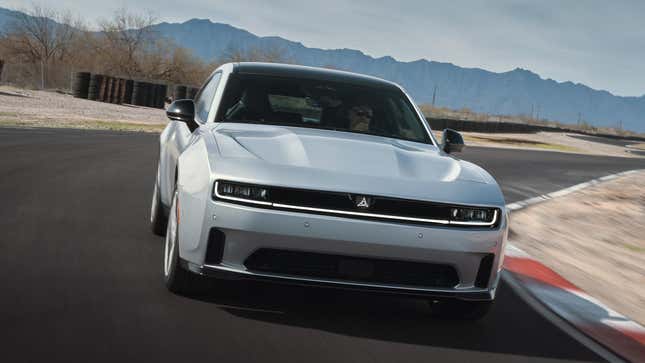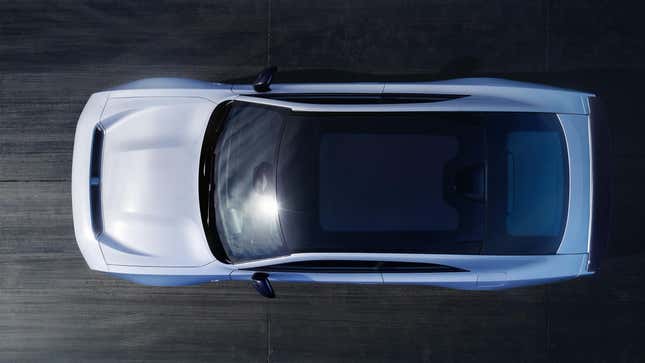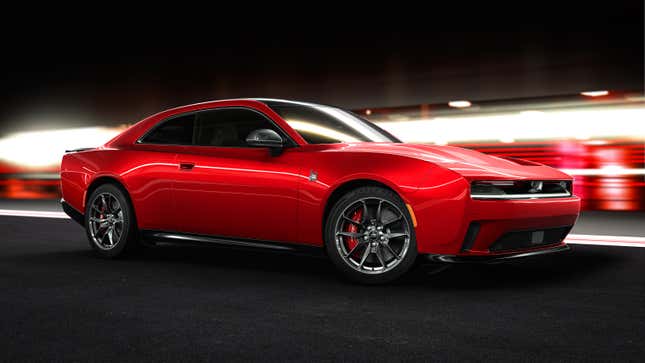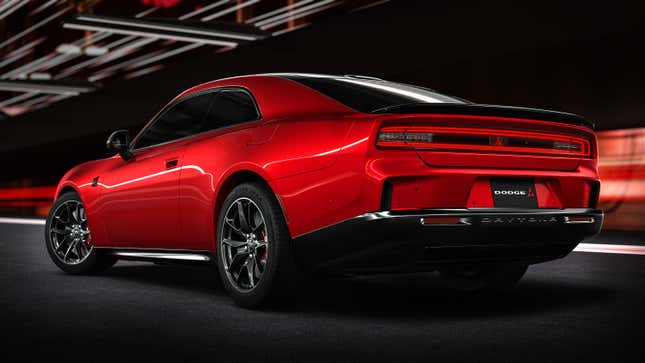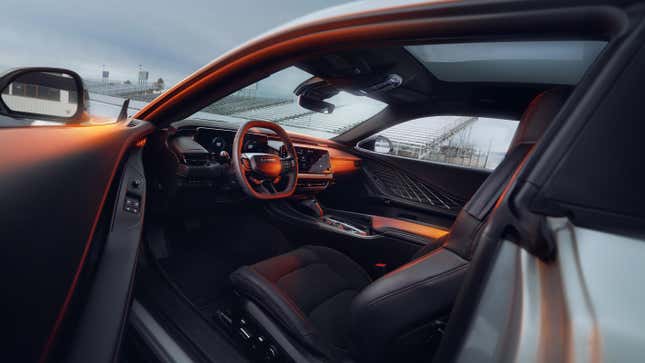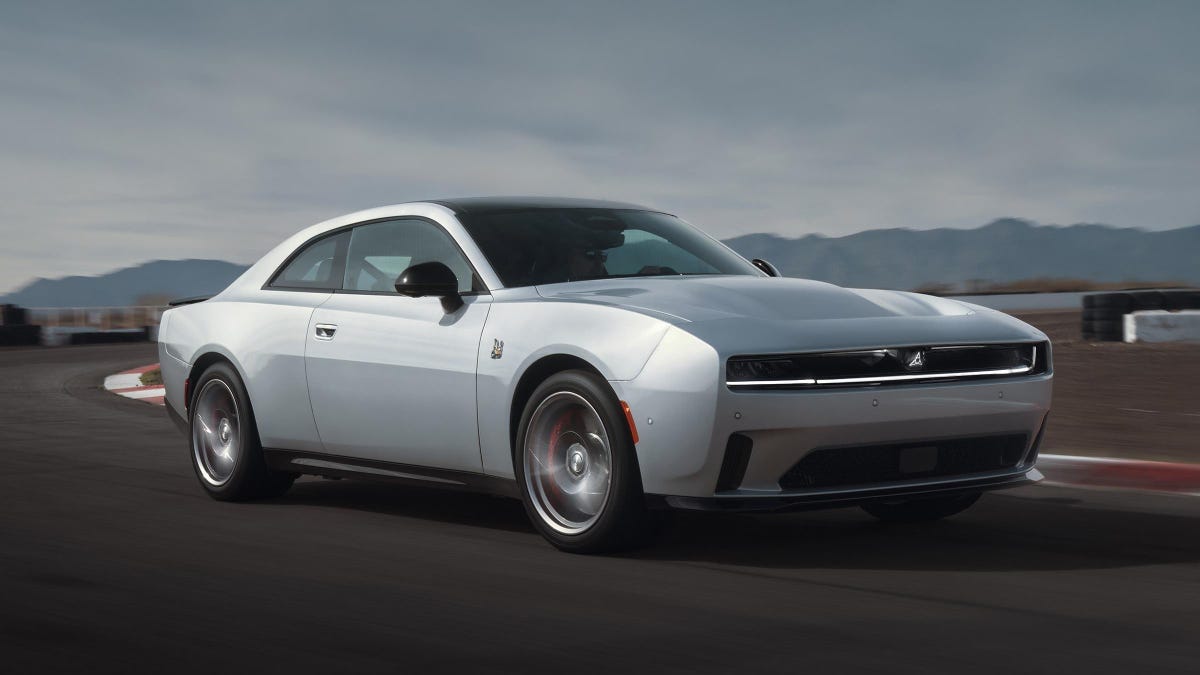We’re just gonna cut to the chase on this one, because there’s a lot to cover; Dodge just unveiled the 2024 Charger, which is entering production in mid-2024 with fully electric powertrains but will gain an internal combustion inline-6 option next year. Its styling sticks close to the concept from 2022, and the new Charger will surprisingly be available with either two or four doors. The all-wheel-drive Charger Daytona EV will be the quickest and most powerful muscle car you can buy thanks to the Scat Pack’s 670-hp powertrain — and the demise of the Chevy Camaro ZL1 and Ford Mustang GT500. And it’s got that Fratzonic exhaust that offers “Hellcat levels of sound intensity” and can even be revved, among other rad performance features like Line Lock and Donut modes.
If you just want to read about the Charger EV’s specs and how they compare to other performance EVs, we’ve got a story for you. If you just want to look through photos of the new Charger, we’ve got a story for you. If you specifically want to read what we know about the ICE Chargers, we’ve got a story for you. But if you want to learn detail about the 2024 Charger, then this is the story for you. Let’s dive in.

The Performance
The Charger is the first production Stellantis model to ride on the brand’s modular STLA Large platform. At launch, the Charger EV will be offered in two different trims: The Charger Daytona R/T and the Charger Daytona Scat Pack. Both models use a 100.5-kWh battery pack with a 400-volt architecture, a 550-kW discharge rate and prismatic cells, and both have an electric motor at each axle. Dodge says both motors each can generate 335 horsepower and 300 pound-feet of torque, and the rear motor has a mechanical limited-slip differential.
Normally the R/T puts out a total of 456 horsepower and 404 lb-ft, or 496 hp with the PowerShot boost function enabled; Dodge says it will hit 60 mph in 4.7 seconds, run the quarter-mile in 13.1 seconds and reach a top speed of 137 mph. The Scat Pack offers 630 hp (or 670 with PowerShot active) and 627 lb-ft, good enough for a 3.3-second 0-to-60 time, an 11.5-second quarter-mile and a 134-mph top speed. Dodge quotes both models as having a curb weight of 5,838 pounds, which is 1,591 pounds heavier than an outgoing V6 AWD Charger and 1,244 more than a Charger Hellcat, and the weight distribution is said to be “near perfect.”
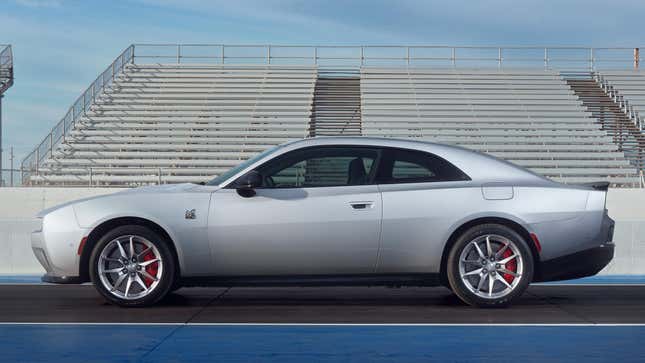
Dodge will offer a range of Direct Connection Stage performance kits for the Daytona, with both models getting two different kits. At launch the R/T comes with the Stage 1 kit (a 40-hp increase) and the Scat Pack is equipped with the Stage 2 kit (and 80-hp increase), but in later model years you’ll have to purchase the upgrades. Dodge previously talked about how these kits can be downloaded and installed via an over-the-air update, which are registered to the car’s VIN. Coming in the next model year will be the SRT Banshee, the highest-performance model that the 2022 concept previewed. We know the Banshee will use the 800-volt version of the platform, and recent reports have pointed to the Banshee getting nearly 900 horsepower.
Retained from the concept is Dodge’s Fratzonic Chambered Exhaust system, that the brand describes as “delivering Hellcat levels of sound intensity.” The system uses two radiators and a series of shapely chambers and speakers to generate real “exhaust” noises, including a distinct (and loud) idle noise. You’ll even be able to rev it. In case you’re boring, there’s also a stealth mode for the exhaust.

A Track Package for the Scat Pack includes 20-inch wheels wearing Goodyear Eagle F1 Supercar 3 tires, sized 305/35 up front and a massive 325/35 in the rear. The Track pack also adds Brembo brakes with 16-inch rotors and six-piston calipers up front, the largest brakes on any production Dodge, and available dual-valve semi-active suspension. Every Charger EV has a multi-link suspension setup front and rear, and even the base brake discs are nearly 14 inches.
The Charger Daytona’s standard drive modes include Auto, Eco, Sport, Track and Wet/Snow, with the Scat Pack also getting a Drag mode as standard fitment. The Scat Pack also gets a Donut mode, which spins just the rear wheels and will rotate either of the front wheels without traction control kicking in, as well as a Drift mode that offers three levels of slip angle, adds a rear bias to the torque split, softens the front dampers and stiffens the rears, and has the traction control allow for different wheel speed differentials. There’s also a launch control mode with five levels of intensity, and a Line Lock function that locks the front wheels so you can spin the rear tires. Dodge also came up with a new Race Prep system that preconditions the battery by warming it for track driving or cooling it for drag racing. And the infotainment system has lots of performance pages, of course.
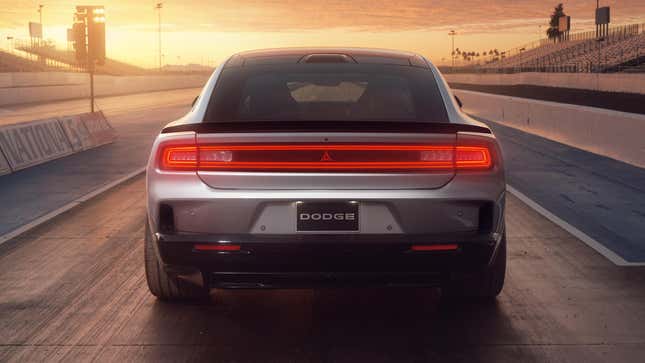
Adjustable regenerative braking can decelerate the Charger at up to 0.3 g, but Dodge doesn’t say whether the cars have one-pedal capability. The R/T will have a range of more than 317 miles while the Scat Pack will have 260 miles of range, and using a 350-kW DC fast-charger they can go from 5 to 80 percent charge in under 33 minutes or from 20 to 80 percent in less than 28 minutes.
The gas-powered Chargers drop the Daytona moniker in favor of the name Sixpack. (Dodge writes that out in all caps, but I’m not doing that.) The Hemi V8 really is dead, so the internal-combustion Chargers use Stellantis’ Hurricane twin-turbo 3.0-liter inline-6 and also have all-wheel drive. The Standard Output will have 420 hp while the High Output version will have 550 hp — more than the old V8 Scat Pack — but no other performance figures or specs have been given. Production for the gas Chargers will start in the first quarter of 2025.
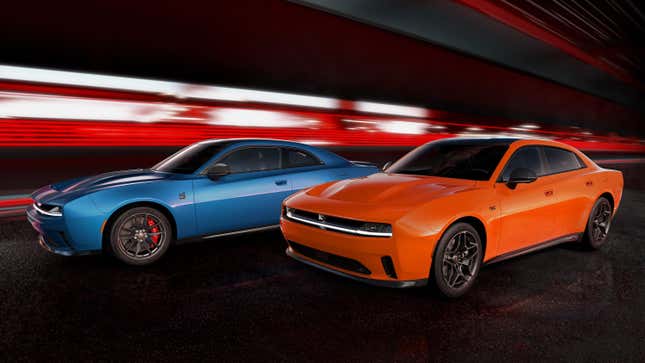
The Design
The 2024 Charger sticks very close to the concept, though its proportions are a little less exaggerated and a little more goofy looking — I’m a massive fan, but some of my fellow Jalops aren’t. A lot of the muscle cars that the Charger takes inspiration from are kinda goofy anyway. The most obvious inspiration comes from the second-gen Charger that was sold from 1968 to 1970. It’s got a dramatic coke-bottle shape and a prominent greenhouse, with full-width wraparound rectangular light bars at both ends, a trio of lower intakes in the front bumper and a steep rear diffuser. The Daytona EV has what Dodge calls the R-Wing nose, which is an air pass-through integrated into the grille and hood, and the Charger is the first application of the retro Fratzog logos, which are illuminated.
Somehow, Dodge was able to keep the existence of the new four-door Charger a secret. Aside from the additional doors the two cars look pretty much identical, with the sedan getting a slimmer C-pillar but the same rake to the rear window, and the same front and rear end designs as the coupe. While I prefer the slightly weirder design of the two-door, the four-door Charger looks awesome, with proportions more akin to those of classic ’60s rear-drive muscle sedans. The gas-powered Chargers will have slightly different styling, getting larger intakes in the front bumper and ditching the R-Wing in favor of a more traditional grille and bulged, vented hood.
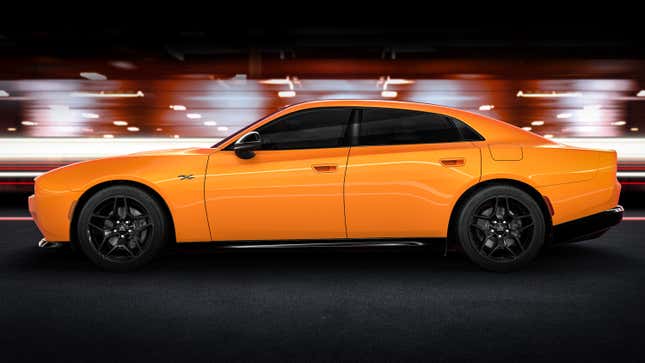
It’s a damn big car, too. The two-door Charger’s 121.0-inch wheelbase is an inch longer than the old four-door Charger and five inches longer than the Challenger, and its 206.6-inch overall length is around six inches longer than the old Charger and about nine inches longer than the Challenger. Height is up by around two inches, and the new Charger is nearly five inches wider than the standard Charger and Challenger and almost two inches wider than the widebody versions of the outgoing cars. (Dimensions have yet to be announced for the four-door, but it’ll have the same wheelbase.) It’s got a powerful stance, even on the base 18-inch wheels.
My favorite part of the Charger’s design is what Dodge calls the “hidden hatch.” Both the two-door and four-door Chargers use a liftback instead of a traditional trunk, which is both way cooler and way more useful. With the rear seats up the two-door Charger has 22.8 cubic feet of space, 6.3 cubes more than the old Charger and 6.6 greater than the Challenger, and with the rear seats folded flat that space grows to 37.4 cubic feet. There’s a 1.5-cubic-foot frunk, too.
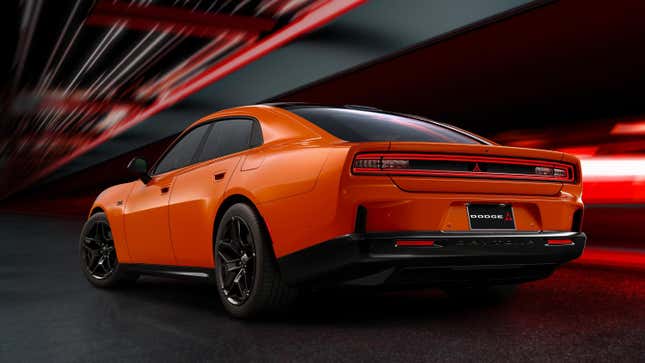
Eight colors will be available at first: After Dark, Bludicrous, Destroyer Grey, Diamond Black, Peel Out, Redeye, Triple Nickel and White Knuckle. A Blacktop package predictably blacks out the exterior trim. Stellantis is great about releasing new colors, retro sticker packages and other special edition designs on its muscle cars, and I’m sure the new Charger will keep up that tradition — I’d love to see one with a Road Runner–style nose cone and rear wing, or an electric update of a Shaker hood.
The Interior
The 2024 Charger’s cabin has also stuck extremely close to the concept, and it’s a massive step up not only from the old cars, but from any other car that Dodge has ever made. Also more reminiscent of classic muscle cars, there’s a low dashboard and sculpted door panels with “linework and texture” that Dodge says is a reinterpretation of the ‘68 Charger. The thick heated steering wheel has a flat top and bottom, and the shifter has a sick pistol grip design and sits near a prominent start button on the center console.
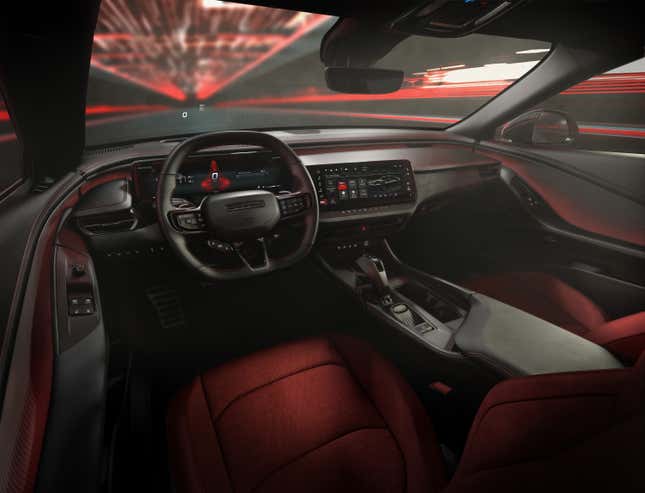
A 10.3-inch gauge cluster screen is standard, but a wide 16-inch screen is optional and looks really cool inset into the dash. The 12.3-inch center screen is angled toward the driver, and it has physical volume and tuning knobs plus buttons for the seat heat and ventilation set into the screen surround. Just below the screen is a row of seemingly touch-sensitive buttons for the climate control. The Uconnect 5 system has wireless Apple CarPlay and Android Auto, TomTom navigation, and Alexa integration, among other media apps.
Cloth and vinyl seats come standard — vinyl, what a throwback! — but don’t worry, you can get Nappa leather in a color called Demonic Red. Depending on what package you get, the Charger comes with awesome performance bucket–style front seats that have a fixed headrest, and suede and carbon-fiber trim is available. Dodge calls the 64-color ambient lighting system the Attitude Adjustment; it uses different animations, colors and intensity to react to different events and wraps 270 degrees from each door around the instrument panel. The infotainment system’s design changes depending on drive mode, and everything is personalizable.

Everything Else
Another major upgrade is on the tech front. In addition to the overhauled infotainment system, a 9-speaker Alpine sound system with a subwoofer is standard, and an 18-speaker Alpine system is optional. You can get an augmented reality head-up display, a digital key and a track-day data recorder with an integrated dashcam.
Standard on every Charger is Active Driving Assist, Stellantis’ Level 2 hands-free system. Other standard safety features are adaptive cruise control with stop and go, automated emergency braking with forward collision warning and pedestrian detection, blind-spot monitoring, lane-keeping assist, a driver monitor and traffic sign recognition; a 360-degree camera system, active blind-spot cameras and parking sensors are optional.
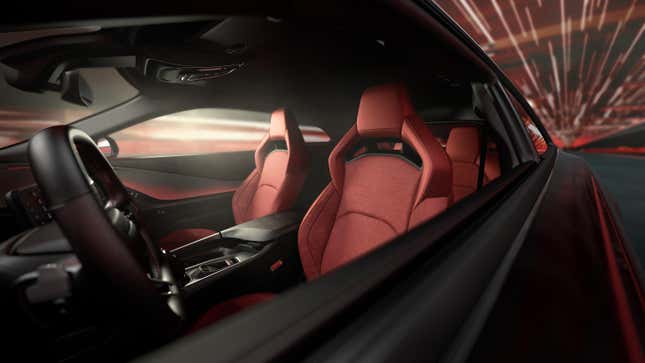
Every new Charger will be built at the Windsor Assembly plant in Ontario, Canada, which currently only produces the Chrysler Pacifica minivan. The two-door Charger Daytona R/T and Scat Pack will enter production in mid-2024, with the four-door Daytona R/T and Scat Pack starting in the first quarter of 2025. Also beginning production in Q1 2025 will be the gas-powered Charger models, and the Banshee should go into production later 2025.
There is still one major unknown when it comes to the new Charger: Price. In a digital backgrounder ahead of the reveal, Dodge spokespeople refused to discuss how much the 2024 Charger will cost. We’ll hopefully learn about pricing soon, and I wouldn’t be surprised if there’s some sticker shock, especially for the Daytona EV.
